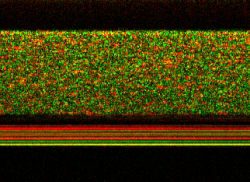
This image, captured by the UNC team, shows gold nanorods diffusing into a layer of mucus. The speckles in the top part of the image are due to rapid light intensity fluctuations caused by the gold nanorods as they move through the mucus. The black layer underneath is human lung cells, and the lack of green speckle shows that the nanorods have not penetrated the cells. The lines of solid color are the membrane. Credit: Amy Oldenburg, et al/UNC
People with lung diseases such as cystic fibrosis and COPD can suffer from mucus build up in the lungs, limiting their breathing and making life pretty miserable. Mucolytic drugs that thin the mucus can be used, but following up with patients to see how these drugs are working deep within the lungs has been practically impossible. Researchers from University of North Carolina at Chapel Hill will soon be reporting at the Optical Society’s upcoming 98th Annual Meeting on a new nanotechnology technique to analyze the viscosity of mucus.
The team used gold nanorods, which were deposited on top of a mucus sample, and a laser to watch how the rods penetrated through the sample. They discovered that the slower the rods mixed into the mucus, the more viscous it was. More importantly, though, since mucus within the lungs doesn’t stay put, but moves along helped by cilia, the technique works just as well when the mucus slides atop stationary human lung cells.
The researchers note that this technique, so far tested in a laboratory environment, is still a long way from being offered to doctors for clinical use since it’s not known whether the nanorods will eventually exit the lungs and what effects they may have on the body.
Optical Society: All That Glitters is….Slimy? Gold Nanoparticles Measure the Stickiness of Snot…
